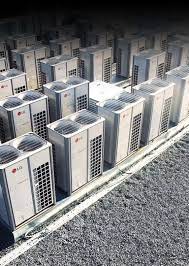
Variable Refrigerant Flow (VRF) systems represent a paradigm shift in the world of Heating, Ventilation, and Air Conditioning (HVAC). Renowned for their energy efficiency and precise climate control capabilities, VRF systems have gained popularity in both residential and commercial settings. However, like any technology, VRF systems come with their set of advantages and disadvantages.
Advantages of VRF Systems:
- Energy Efficiency: One of the primary advantages of VRF systems is their remarkable energy efficiency. Unlike traditional HVAC systems that operate at a constant speed, VRF systems can adjust the flow of refrigerant based on the cooling or heating needs of different zones. This flexibility leads to significant energy savings, making VRF systems an environmentally conscious choice.
- Individualised Zoning: VRF systems allow for precise zoning, enabling independent temperature control in different areas. This zoning capability enhances comfort and energy efficiency, as only occupied spaces receive conditioned air. It is a valuable feature for both residential and commercial spaces, offering personalised climate control and reducing energy wastage.
- Quiet Operation: VRF systems are known for their quiet operation. The variable speed compressors contribute to reduced noise levels, making them suitable for applications where low noise is essential, such as bedrooms, offices, or hotels.
- Design Flexibility: The modular nature of VRF systems provides design flexibility. They are well-suited for buildings with diverse heating and cooling requirements. The system's adaptability allows it to cater to various architectural designs, making it an attractive option for both new constructions and retrofits.
Disadvantages of VRF Systems:
- Initial Cost: The upfront cost of installing a VRF system is often higher than that of traditional HVAC systems. The advanced technology, individualised zoning capabilities, and energy efficiency features contribute to the initial investment. However, it is crucial to consider the long-term savings in energy costs and the overall efficiency of the system.
- Complex Maintenance: While VRF systems generally require less maintenance than traditional systems, when maintenance is necessary, it can be more complex. Technicians need specialised training to handle the intricacies of VRF systems. This factor may lead to higher maintenance costs and the need for skilled professionals.
- Climate Considerations: VRF systems may face challenges in extremely cold climates. In heating mode, the efficiency of some VRF systems may decrease as temperatures drop. However, advancements in technology are addressing this limitation, and some VRF systems are designed to operate efficiently in cold climates.
- Limited Retrofit Options: Retrofitting an existing building with a VRF system can be challenging, especially if the structure was not initially designed for such a system. The absence of ductwork may pose difficulties in spaces where retrofitting is required.
In conclusion, the advantages of VRF systems, such as energy efficiency and individualised zoning, make them an attractive choice for many applications. However, the decision to opt for a VRF system should be made considering factors like initial costs, maintenance complexities, and specific climate conditions. As technology continues to evolve, addressing current limitations may further enhance the appeal of VRF systems in the HVAC landscape.

No comments yet